When it comes to choosing the right fabric for comfort, the question often arises: Is polyester stretchy? Polyester, in its pure form, might not be as stretchy as some might hope. However, the stretchiness of polyester largely depends on its weave .
Synthetic fabrics invaded the market not so long ago, but they already won the place in people’s hearts. Durable, long-lasting, and handy, these materials are really miraculous.
Polyester is one of them. We can find hundreds of various items made of it, but often consumers become curious whether this fiber is able to stretch.
The Nature of Polyester
Polyester is popular and used extensively in the fashion industry. It’s known for its durability, but is it stretchy? On its own, polyester doesn’t have the same elasticity as some other fabrics. In fact, in some cases, polyester will not stretch significantly. However, when polyester is blended with other materials, it can become more elastic. It’s essential to remember that polyester in its pure form doesn’t stretch as much.
Is polyester stretchy?
Yes, the polyester is stretchy. Polyester is stretchy by its nature, it is very elastic and soft, and it does not lose its original size and shape. Even 100% polyester does not stretch out. Polyester dries quickly, “breathes,” and it is convenient to play sports in these clothes.
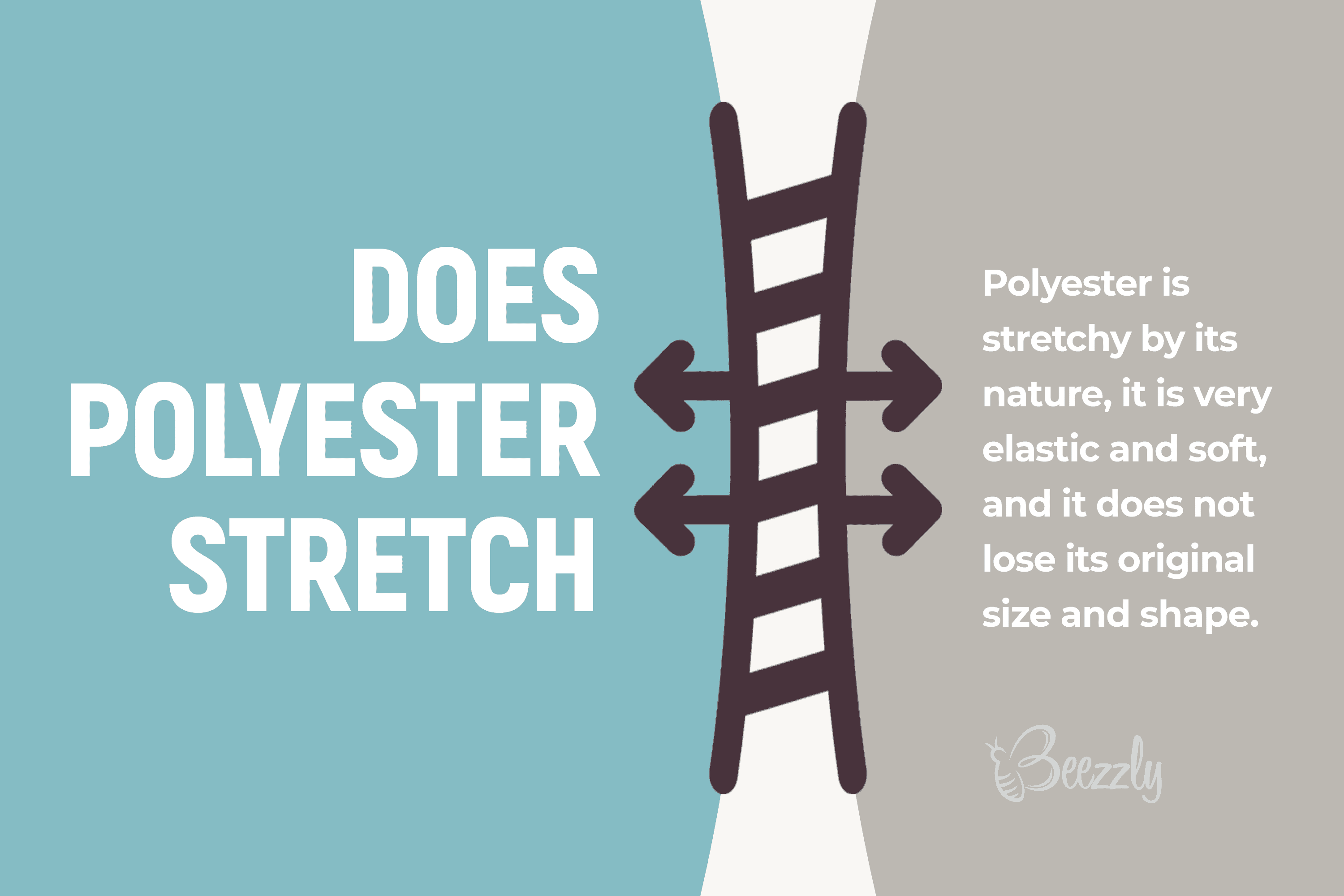
The Magic of Blending
When polyester and cotton fibers are combined, they form a composition known as polyester-cotton or poly-cotton.
This combination strikes a balance between the durability of polyester and the softness of cotton. Garments crafted from this composition feel soft, providing comfort while maintaining the resilience of polyester.
In the same vein, a union of polyester with rayon or polyester with 5% of another fabric can amplify the fabric’s elasticity.
On occasion, a combination of polyester with 8% of another fiber can produce that exceptionally stretchy feel in clothing. Specific polyester compositions, such as polyester knits or polyester satin, display varied stretch levels. How polyester yarn is interwoven or knitted into the fabric significantly influences its elastic properties.
The Fabric Dynamics
When one encounters a garment made with polyester, the question often arises: is polyester fabric stretchy? While polyester is known for its durability and widespread use in the fashion industry, its stretchiness isn’t a given.
Indeed, the elasticity of polyester depends largely on its composition and the way it’s woven.
Density of polyester
Den is an indicator of the linear density of threads in a fabric, the ratio between weight and length. 1d is 1 gram of thread per 9 kilometers.
The higher the numerical indicator, the greater the density.
- 300d – is a fairly dense fabric that is widely used in sports and tourist equipment, clothing and accessories, threads, yarns.
- 500d – is a dense material from which equipment for various sports is made. It is also used for truck tarpaulins, tents, backpacks and bags.
- 600d – resistance to an external aggressive environment. Low electrical conductivity, good water repellency. The scope of application of the fabric is the same, but the products are obtained one class higher.
- 900d – this density of the fabric does not allow not only water to pass through but also ultraviolet rays. High-quality equipment is suitable for extreme conditions. By combining polyester with nylon, incredible strength and elasticity are achieved.
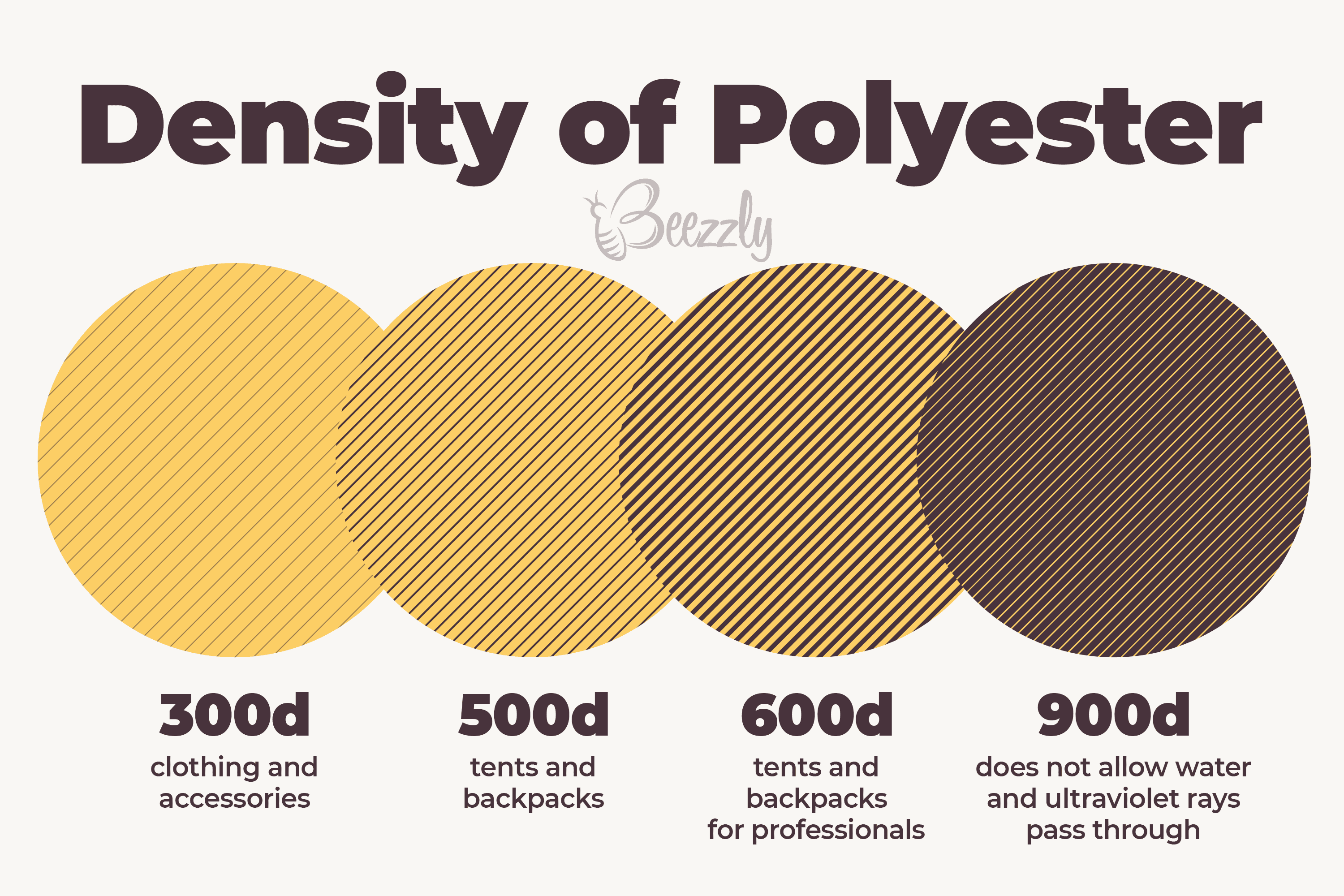
How stretchy is polyester?
Polyester is a very stretchy fabric and perfectly retains shape. It depends on its density how stretchy it is. An ordinary 300d polyester like we use for clothing stretches really great. It does not wrinkle, and you can use it for quite a long time.
Why Polyester is a Favored Choice
Polyester is an excellent choice for many garment manufacturers. It’s versatile, durable, and when combined with the right materials, can be super stretchy. A polyester t-shirt or a piece of polyester made with the right proportions can rival the comfort of pure cotton.
Moreover, polyester is wrinkle-resistant, making it a favorite for those seeking low-maintenance clothing.
Polyester is also blended with other materials for specific purposes. For instance, a polyester stretch in jeans ensures they fit snugly, adapting to the wearer’s shape.
Polyester and cotton blends are common, but polyester is often blended with other materials like spandex or rayon to achieve a particular feel or functionality.
When shopping, if you sell polyester items, it’s essential to note the blend and understand how to care for polyester properly.
Unique Properties of Stretch Polyester
Polyester fibers have absolutely unique attributes. While they can be sturdy and resilient, they can also be woven or combined with other materials to enhance their stretch.
Polyester clothes tend to be versatile, and their fit can be adjusted based on the weaving technique and composition. The adaptability of polyester makes it a favorite among manufacturers and consumers alike.
Polyester is a great choice for those who seek a harmonious composition that offers both form and function.
Understanding Stretch in Fabrics
Not all fabrics are stretchy. The stretch of a clothing item made from polyester or any other fabric depends on its blend and weave. When you come across a fabric that you’ll love, it’s good to test its stretch if you pull on it gently.
This way, you can gauge how it might fit or feel when worn. Remember, while some fabrics, like polyester, might have a natural give, others might require a blend to achieve that desired stretch.
Types of Polyester Fabrics
There are various types of polyester fabrics, each with its own unique properties. Woven fabric, for example, tends to be less stretchy compared to knitted polyester. However, woven polyester can still offer a degree of stretch, especially when combined with other materials.
Garments made purely from polyester might not provide the same elasticity as those that incorporate polyester with other fibers. However, the introduction of spandex in a polyester apparel enhances its stretch capability. Today, many garments in the market feature a mix of polyester and spandex, ensuring both durability and flexibility.
In the world of fabrics, debates often arise about the superiority of one material over another. In the polyester vs cotton debate, for instance, each has its merits. While cotton boasts natural breathability, polyester excels in durability and potential elasticity, especially when fused thoughtfully with other fibers.
How different types of polyester stretch?
- Cotton : Moderate stretch factor
- Microfiber : Low stretch factor
- 100% : High stretch factor
- Woven : Low stretch factor
- Blended: With Rayon or Spandex – Moderate stretch factor
- Knitted : Moderate stretch factor
- Waterproof : Low stretch factor
Why Choose Polyester Blends?
The beauty of a polyester combination lies in its versatility. Whether it’s a for athletic wear or everyday casuals, this mixture ensures the garment remains durable while providing the desired amount of stretch. Not to forget, integrating polyester with spandex guarantees that the outfit returns to its shape after being stretched, reducing wear and tear in the long run.
Jordan polyester
This fabric with the addition of polyurethane and poly blend stretches well. Has a smooth iridescent surface of high wear resistance. It is waterproof and windproof.
Dispo polyester
Dense polyurethane-impregnated fabric stretches worse than Jordan, but it does. Capable of repelling water and dirt protects from wind.
Prince polyester
Is a matte silky fabric with waterproof treatment and windproof properties with excellent stretch properties.
Bonding polyesterIs a dense, breathable fabric that protects against the cold. It gives comfort and warmth in winter, often children’s outerwear is sewn from it. Stretch well and great for toddlers.
Trilobal polyester
Has a beautiful mother-of-pearl shine, and therefore clothes are made from it mainly for children and women. Stretch worse than bonding.
Taffeta polyester
Shows resistance to moisture and chemicals. The material is in demand in the production of equipment for tourists and rescuers. Low stretch factor
Memory polyester
The fabric remembers the previous impact on it – creasing or smoothing. Low stretch factor

What is the polyester?
Polyester – one of the most widespread and modern materials that are used to create synthetic.
This blended fabric began to be actively used in the light industry only in the early 60s of the 20th century. In addition to sewing clothes, it is also often used to produce packaging, prefabricated structures, etc.
The production path is very complex and has many stages. During the manufacturing process, a variety of natural fibers of cotton, wool, or viscose can be added to it.
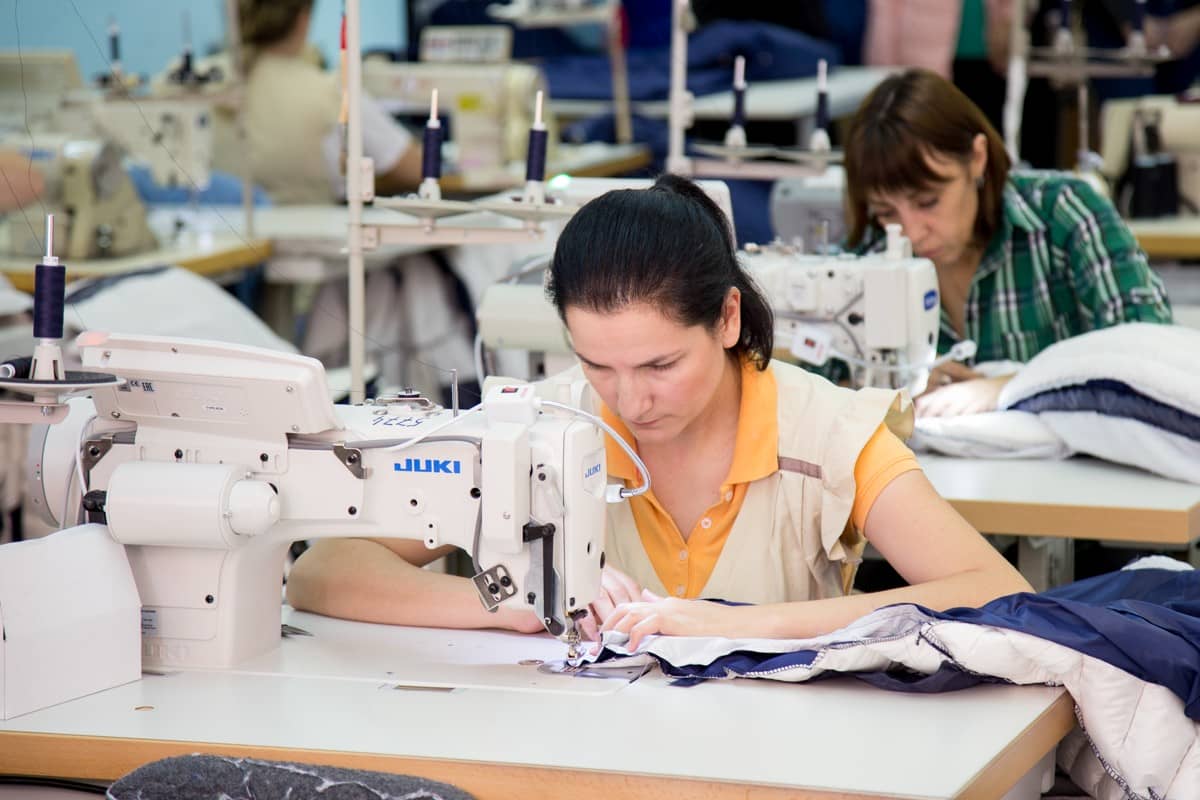
History of appearance
Basic research onpolyesters’ field dates back to the 1930s, with the first publications appearing in 1946.
Despite this, it began to be used in production only in the 60s in various packaging products. These included molding materials, fabrics for packaging bags and containers, adhesive tape.
After polyester’s appearance in the United States, it was shown to the public as a miracle product made by W.K. Birtwhistle and C.G. Ritchie
They said that it was possible to sew unique clothes from it, which were perfectly worn for two months without washing and ironing, and at the same time retained an excellent appearance.
They said that it was possible to sew unique clothes from it, which were perfectly worn for two months without washing and ironing, and at the same time retained an excellent appearance.
How This Material Produced?
To answer the main question, we need to refresh the way this material appears.
Polyester (PE) the most common synthetic fabric.
You can often see such a combination of letters “polyester” on the many types of clothes on the underwear.
But not only fabrics but also plastic containers, badges, and bags are made with this chemical combination.
Such a variety of uses is because, at temperatures above 40 degrees, polyester does not shrink and save its shape.
In the production of clothes, this quality is also a plus since all the folds, clamps, and the clothes’ original shape will remain unchanged even with numerous washes.
A multilevel chemical reaction of monomers produces polyester.
It is made from compounds found in petroleum.
These include ethylene glycol and terephthalic acid.
The creation of such a chemical industry product began in the distant 30s of the last century in Great Britain.
But the patent was received only in 1945.
Polyester is available in 3 states
- film
- fiber
- plastic
How does polyester feel like?
Polyester products feel like different fabrics.
It can be cotton, wool, and even silk.
By the way, 100% polyester (polyester, PE) is called “decorative silk“.
What kind of fabric it turns out depends on the production method and additional fibers‘ presence in the material.
Since polyester is a man-made thing, it is synthetic. The fiber is produced by causing a reaction between air, water, petroleum, and coal.
By the way, another well-known artificial textile, elastane is produced with the use of polyester-made components and the way of manufacturing is pretty similar to both the fibers. The only distinction is the stretchiness of elastane compared to its counterpart.
In a hot vacuum surrounding, the initial material is kept for a long time and then threads are formed. Those are spun creating the final durable material.
Because of the high popularity, polyester has become quite cheap material to buy which makes it one of the most affordable fabrics in the world.
The Craftsmanship Behind Polyester
The process of how polyester is made has evolved over the years, leading to innovations in the fashion industry. This synthetic fiber has been transformed into various forms, ensuring a polyester fit that suits a plethora of garment types. From evening gowns to everyday wear, polyester’s presence is undeniable.
Polyester’s Varied Compositions
A noteworthy aspect of polyester is its adaptability. For instance, an outfit boasting a polyester and 5% spandex might be ideal for sportswear, offering a slight stretch for athletic activities. On the other hand, a more luxurious polyester and 8% silk could be perfect for a more formal and elegant look.
The main characteristic of polyester clothes
100% polyester can be a thin translucent veil or strong raincoat fabric.
The main characteristics may vary depending on the method of production and processing of the fabric.
But the main properties of polyester are always the same:
- It is similar to cotton.
- The fabric is durable and lightweight
- It perfectly retains its shape (even when heated)
- Wrinkles, but not as much as natural materials
- Not sensitive to sunlight and microorganisms
- It is easy to care for and washable
- Dries very quickly
- Low-cost price
- It is pleasant to the body and has a beautiful appearance
- Flexible to processing
- Has an antistatic effect
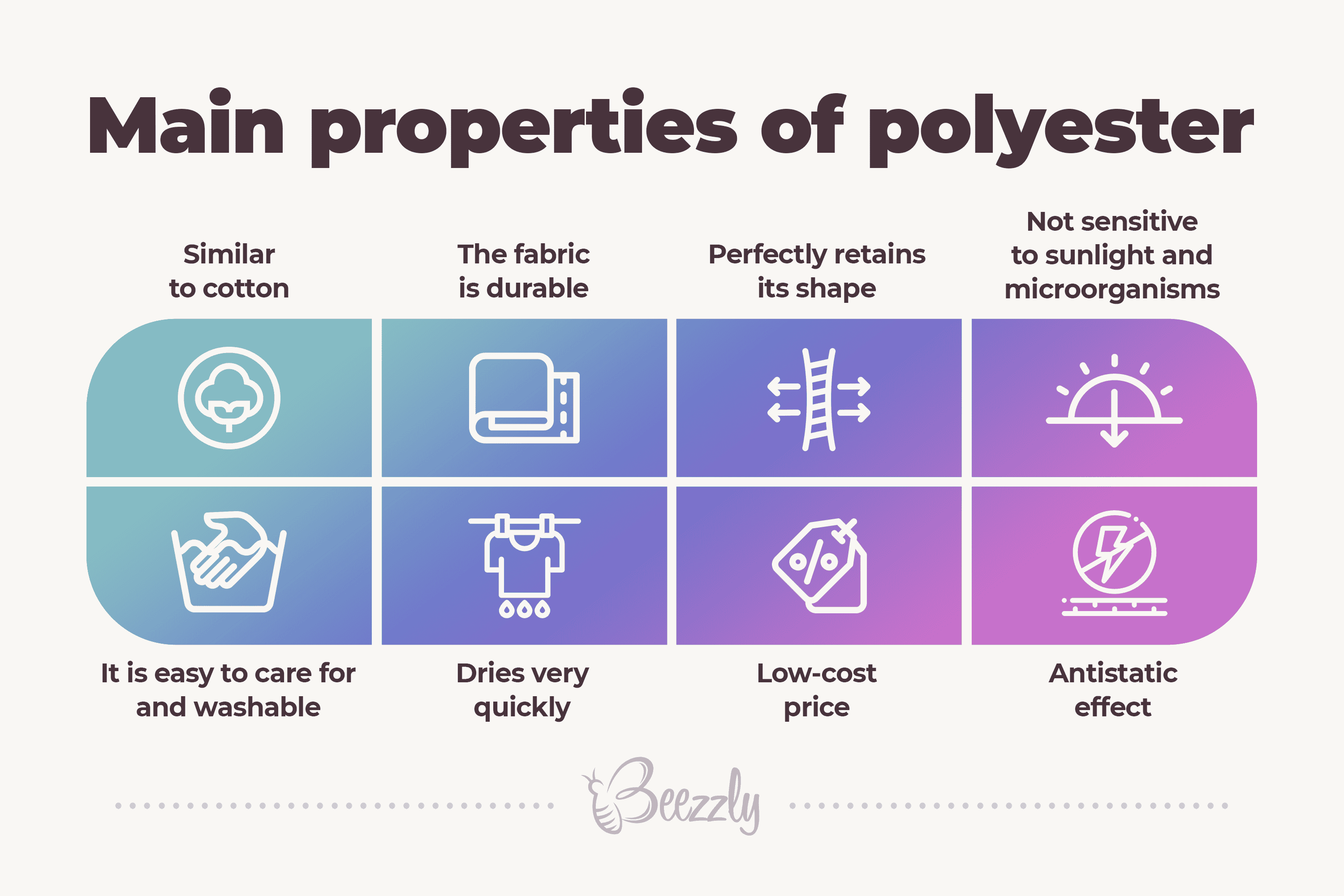
Main disadvantages of the polyester
One of the disadvantages is that it is poorly breathable and therefore not very comfortable to wear at high temperatures.
The high quality of polyester made it possible to use it to create reliable travel and military equipment.
Cons and Weaknesses:
- High density
- Inability to use chemical bleaches. Polyester fiber can break
- Static electricity
- Synthetics accumulate static electricity, which can cause dust particles to stick to clothes. These disadvantages can be easily eliminated by using an antistatic agent or special softener. Many manufacturers add antistatic fibers to the yarn
- Some rigidity of the material. Sometimes elastane or cotton is added to the polyester to make it softer
- If technology was violated, polyester fiber could cause allergies. When buying clothes, remember that too cheap polyester can be harmful to your health
- The fiber is difficult to dye
What Are Its Properties?
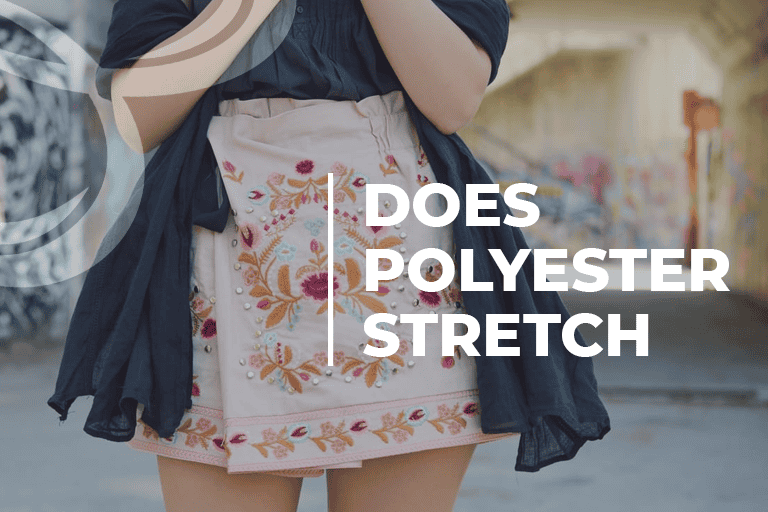
- The fibers of this material are hollow which allows them to keep the warmth of the human body. Thanks to this feature, polyester is a welcomed guest in a wardrobe of any sports lover and those who enjoy long walks on the cold days since this keeps you warm.
- It’s water-resistant which means that sweat won’t be absorbed by the apparel. A perfect choice for physical activities.
- It adds strength and tear-resistance to other fabrics, that’s why polyester is often mixed with other materials.
Since polyester easily restores the initial shape, shrinking it can be quite a challenge, but if you need to make such apparel smaller, a couple of ways exist how we can shrink polyester. In particular, exposing it to heat (both when laundering or drying) can have the desired result.
Does Polyester Stretch?

What about stretching? It’s an important moment since our clothing has to sit properly letting us move freely.
The good news is that polyester stretches a bit naturally. The manufacturers took care of this feature and made the material that would be comfy for the wearer.
No matter how actively it is stretched while being worn, the material will return to its initial shape and size once you take it off. That’s the good thing since there is no need to worry that one day your training suit or leggings will become two sizes bigger.
Of course, it is important to consider that, if the apparel is made of blended material that is part polyester and part natural, its stretchiness can be reduced.
In terms of this, people often get concerned about using polyester and shift to natural materials like cotton. Which one is better, cotton vs polyester? Well, both have specific features that fit different needs of wearers, but basically, cotton is more preferable since it’s safe on skin and often even more affordable than artificial textiles.
Another issue that often bothers people is that nylon vs polyester thing. In particular, which one is better. Both are synthetics, but certain distinctions do exist. For instance, even though nylon is stronger, its counterpart is more fast-drying, lint-resistant, and absorbs colors easier.
Another issue that often bothers people is that nylon vs polyester thing. In particular, which one is better. Both are synthetics, but certain distinctions do exist. For instance, even though nylon is stronger, its counterpart is more fast-drying, lint-resistant, and absorbs colors easier.
But even though this material is long-lasting and heat-sustainable, avoid exposing it to the high temperatures to protect from extreme shrinkage.
Polyester Fabrics Care 8 tips
One of the reasons polyester is a great choice is its maintenance ease. Polyester also stands out for its resistance to wrinkles, making it a top pick for those always on the go. Yet, it’s essential to remember that not all polyester garments are the same.
There are no special requirements for the care of polyester, but in order to preserve the original characteristics of the product, simple rules must be followed when washing and ironing it:
- Check the label first
- This is really important for clothes with special properties f.e heat and moisture protection
- When choosing a washing mode, it is important to remember how many degrees polyester can withstand. Typically, polyester can be washed at 104 F and below. Hotter water will deform the fiber, and the thing will lose its shape
- It is best to choose a mode for washing synthetics or delicate.
The fabric cannot be bleached. Clothes with tough stains can be dry-cleaned - Hand wash is advisable for particularly delicate fabrics
- It is better to wash things, turning them inside out so as not to damage the front side
- Certain types of polyester, such as knitwear, must not be twisted too much after washing
- To prevent the fabric from wrinkling, you need to hang the product on a hanger after washing and straighten it well
Mixed fabrics with polyester
Polyester and Polyamide
If it is diluted with polyamide, polyester loses some of its heat resistance and does not absorb moisture.
Polyester and Spandex
As a result of these fibers’ combination, we get strong and very elastic material.
It is usually used for compression underwear, durable sportswear, tight-fitting jerseys, gloves.
Thanks to the spandex fibers, the material becomes less dense and more breathable, and it stretches well. However, the combination is not as resistant to fading as pure polyester; snow-white fabrics can turn yellow in the sun.
Polyester and Cotton
Cotton is a classic example of hygroscopicity, hygiene, naturalness, and simplicity.
Combining it with polyester in a ratio of 65% and 35%, the fabric becomes great and unchangeable for underwear.
Jerseys made of cotton with polyester do not fade, do not stretch, they can be worn, and can be used longer.
Polyester in Modern Fashion
In debates like polyester vs other material, polyester often stands out for its versatility. Whether it’s in the sleek look of a polyester satin evening dress or the casual feel of a beach shirt, its adaptability is evident. Modern trends even see polyester being used in innovative ways, with designers exploring blends that were once considered unconventional.
How to iron polyester if the clothes are crumpled?
This can be done, but at a minimum temperature from the seamy side through a thin cotton or gauze.
Some polyester materials cannot be ironed.
The material, which is 100% polyester, is quite cheap in cost, so it is loved by people who are just beginning to comprehend the basics of sewing if you are one of them, polyester is a good start.
How to hand wash polyester?
If you want to hand wash your new polyester blouse, first dissolve the detergent in water at room temperature (no higher than 104 degrees).
How to wash a polyester Dress?
To clean your polyester dress, you have to soak it in cool, warm water with 3 tablespoons of white vinegar. Then, wash your dress in the washing machine on a standard or cold washing regime. You can choose a delicate spin cycle to prevent stretching .
A polyester dress can be washed not only by hand but also in a washing machine. At the same time, the temperature regime of water can be different, but in most cases, it is + 104°F, although there are still exceptions to the rules – fabrics made of polyester fibers that can be washed at a temperature of + 140°F.
Quick Review
[mv_video aspectRatio=”true” doNotAutoplayNorOptimizePlacement=”false” doNotOptimizePlacement=”true” jsonLd=”true” key=”mhxhvccazkdfm70bbq4u” sticky=”false” thumbnail=”https://mediavine-res.cloudinary.com/v1599170081/ahr7fgzzznhi7fzxeikt.jpg” title=”Does Polyester Stretch? Detailed Fresh Guide” volume=”20″]
[wp-faq-schema title=”Frequently Asked Questions”]

Does polyester run small? Does anyone know it? Can’t decide which size to choose!
I’d not say it runs small, it rather runs true to your size. If I were you, I’d consult the adviser from the store, they must know it.
Can you please help me? Should I size up for polyester? Thanks a lot!
No, I think you shouldn’t. The producers of clothing usually take into account the amount of stretch and sew clothing to normal sizes.
Is polyester spandex breathable? Shall I buy t-shirt for my running training made of it?
I’d rather not do that! These two are the worse materials for running! As for me, at least. Spandex is not breathable, and polyester is no better. Better go for cotton.
How do I permanently stretch polyester? Can you advise a safe method?
I use warm water and hair conditioner. Simply soak the item for ½ an hour and then wring it. And then simply pull it to stretch and hold with heavy items e.g. books until it’s dry.
I want to buy a pure polyester t-shirt for the gym. Can anyone tell is 100% polyester stretchy? Will it be ok for the training?
I guess it’s fine since the fabric is reasonably stretchy, but don’t expect it to be elastic.
Does polyester shrink in the dryer? Thanks a lot!
It does, That’s why if you tumble-dry it, do that on the low heat.
I preffer dry flat for it))
Maybe someone knows the answer (I’ll be very grateful!). Does polyester fit tighter than cotton?
I assume it does. Cotton is not so tight, a bit more loose – I judge from my training polyester t-shirts that ARE tight.
sure polyester is tighter but, i love how cotton fits and it is very soft, so I preffer cotton vas polyester for trainings for me)
Does 100% polyester stretch? I have quite a few polyester-containing garments in my wardrobe, but I have already noticed that they tend to stretch when being washed, for example. It’s not that they stretch a lot, but still for me it’s noticeable. So I was wondering, maybe pure polyester is not like that?
I’m not sure about pure polyester, but I guess that any type of this fabric, whether pure or a blend, will be stretchy more or less. That’s because, as far as I know, 100% polyester also has little stretchiness.
Does polyester stretch in jeans? See, the problem is that almost all my jeans are cotton, and I’m tired of throwing them away because of stretchiness! No matter what I do, they will stretch out sooner or later! So I thought that maybe, jeans that have polyester will show less of that stretchiness? What do you think?
I guess your words make sense. At least for me. Cotton jeans are indeed stretchy, I had that issue with them, too. But since polyester is synthetic that almost doesn’t stretch, I assume that it will also reduce the stretching ability of cotton if blended with it. But it’s just my guess!
I’ve never been into synthetic clothes much before, but my daughter buys preity much outfits that contain polyester in particular. And I find it rather tricky to wash. Since I don’t want to ruin my child’s clothes, I’d like to ask your opinion: does polyester stretch after washing?
It will stretch if you launder your polyester items using a heavy-duty cycle. But if you wash them by hand or by using a hand wash-cycle, it will be fine.
Does anyone know how to stretch a polyester swimsuit? The one that I bought appeared to be too small for me!
Well, try to wash it using a heavy-duty laundry cycle. You could also try to pulverize it with warm water and stretch manually to adjust to your size, and then just let it dry. That must help, too. Maybe, there are other methods, but I know only these two. Good luck!
I need your help, folks! I have a polyester-cotton blend dress that I’ve recently bought, but when I put it on for the first time, it appeared to be too small for me! Maybe, I messed up with the sizes when making the order, I don’t know. Heck with that! How to stretch that polyester-cotton blend?! That’s what I want to know! Any ideas?
Can you stretch out polyester? I washed my poly t-shirt nd now it seems to be a bit smaller than before. Is it possible to bring it abc to its initial shape?
Oh, I don’t even know! Polyester has absolutely no elasticity. The only ways to stretch polyester are by crimping it, knitting it in a unique layout, or combining it with elastic fibers. Polyester-spandex blend is the most popular combo for creating comfortable, soft, and super stretchy clothing. In your case, I guess you could only try to soak your item in water and then stretch it a bit while damp. It might help, but I don’t promise!
Hi! Thanks for explaining about stretching poly. But here’s the question: does polyester get looser over time? I mean, if I maintain it correctly, will it still stretch?
Hello. Well, it depends on how pure your polyester garment is. See, 100% polyester garments will always go back to their original size eventually. But if you have a mixed piece of clothes that contains poly and another fabric, it may stretch indeed.
Does polyester stretch or shrink?
If it’s pure 100% polyester, it won’t stretch. On the ocntrary, it will return to its initial size eventually (of course, if you maintain it right). But 100% polyester will shrink slightly– over multiple hot water washes and high-temperature dries.
If you wear cotton/poly blends, note that they can also shrink slightly. But if you follow the instructions for polyester garments– cold water wash and cool temperature dry– they will not shrink.
Is polyester stretchy in all dresses? I mean, if the tag says the dress contains polyester, does it mean I can stretch the garment?
Typically, polyester fibers have absolutely no elasticity. The only way to stretch polyester is by crimping it. Also, it can get stretchy if you knit it in a unique layout, or combine it with elastic fibers to create a blended fabric. So, if your dress is pure polyester, it won’t stretch.
Thanks for explaining so much about polyester! I have one more question, though. Does the mix of polyester and spandex stretch? If there’s polyester in this mix, then the fabric won’t be stretchy, right?
Hi! Well, in fact, this mix is known for its superb stretching abilities! Yep, that sounds strange since there’s polyester as you noticed. But still, spandex-poly fabrics are stretchy.
Does polyester stretch in jeans?
As far as I know, polyester doesn’t stretch no matter in what fabric it’s present. If it’s a pair of jeans with polyester, they will more likely retain their shape even better due to polyester disability to stretch and distort.
Hello. I’ve recently had a question that I hope you can answer. Does polyester stretch more than cotton?
Hi! Could you please explain about the fabric called elastane? Does elastane stretch?
Hello! Yes, elastane stretches. In fact, this fabric can be stretched to 4-7 times its length and has great elastic recovery!
Is 95% polyester stretchy?
No. Polyester is the sort of fabric that doesn’t stretch or shrink. And it doesn’t matter how much polyester there is in the fabric.
Hello. I’ve recently had a question that I hope you can answer. Does polyester stretch more than cotton?
You say that polyester fibers typically don’t stretch. Does it mean polyester can shrink, then?
Relative to cotton, polyester is stronger, and it also has a greater ability to stretch. But we would not say polyester stretch way more than cotton.